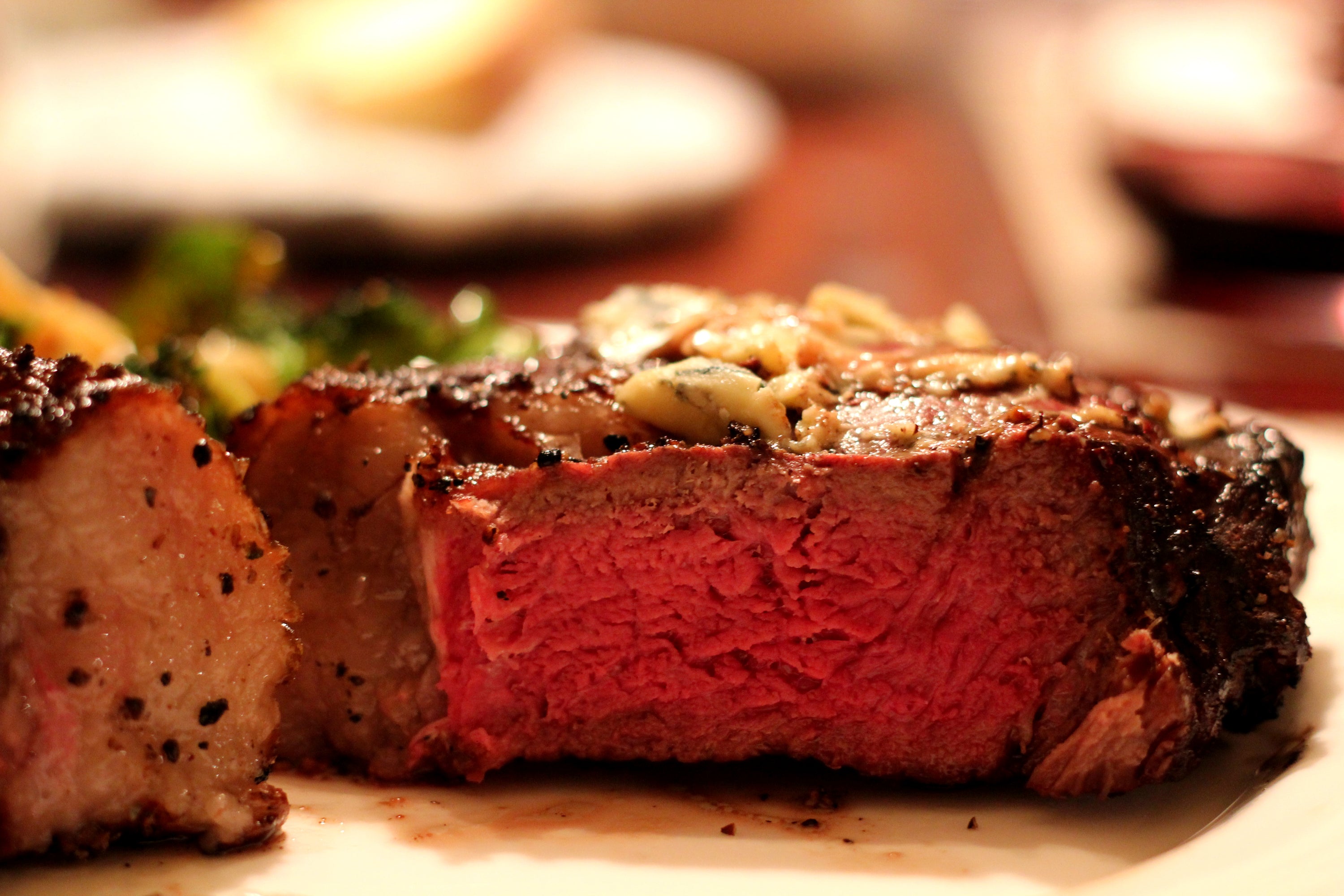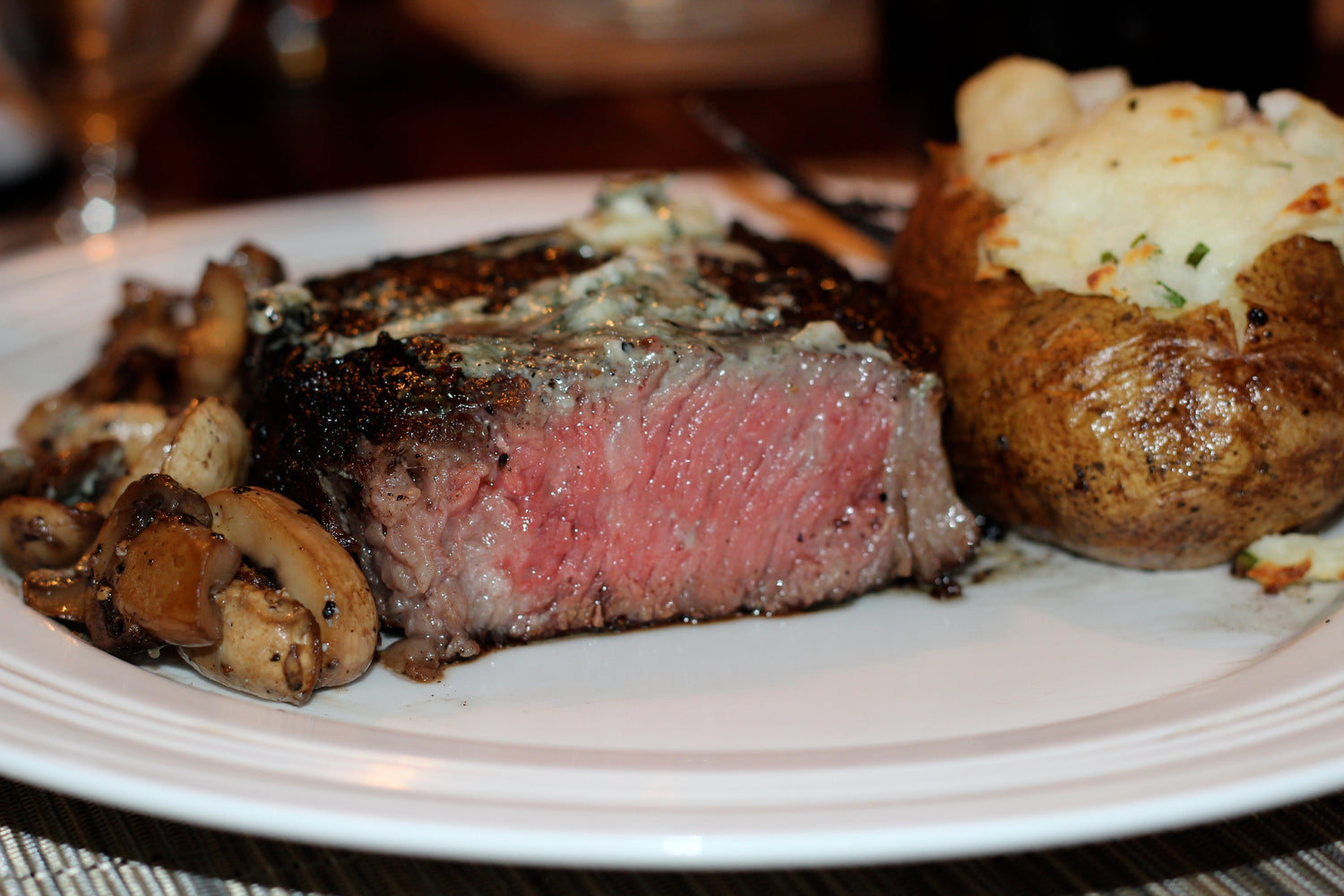Welcome to Meathead Talks, a series of curated articles from AmazingRibs on everything from kitchen science to myth busting to tips for upping your grill game. All articles are written by the Meathead, a brilliant chef and self-proclaimed Barbecue Whisperer whose culinary word are heeded as gospel in many circles.
This guide teaches you how to cook a high-quality steak at home, focusing on selecting the right cuts, grades, thickness, and technique to achieve a juicy, flavorful, and dark steak with bold beefy flavor.
To prepare a truly unforgettable restaurant quality steak, start by dry aging with UMAi Dry. Choose a full subprimal in the best grade of steak with marbling, such as USDA Choice or Certified Angus boneless ribeye or strip loin. Dry age for 35-45 days .
After dry aging, follow these steps:
1) Peel away the UMAi Dry, trim and prepare to steak out.
2) Cut to the desired thickness, such as 1.5" for a ribeye.
3) If you wish, season the steak by salting both sides. (If you haven't dry aged the meat, you may want to follow Meathead's detailed instructions and video for dry brining two hours in advance.)
4) Preheat a grill for 2-zone cooking, ensuring one side is hot and the other is 225°F.
5) Cook the meat on the indirect side, adding wood to the charcoal to prevent color banding and add smoke flavor. 6) Flip the meat every 5 minutes to check the internal temperature.
7) Prepare to sear the meat, ensuring it reaches 115°F interior.
8) Sear the exterior on one side for 3 to 5 minutes, checking frequently to prevent grill marks.
9) Serve the steak simple, with a simple board sauce, like Warm French Potato Salad and Crunchy French Green Beans with a big red wine.
A Deeper Dive, Beginning with the Cuts
Prime steakhouses serve the best cuts, such as ribeyes, porterhouses, T-bones, strip steaks, and tenderloin cuts like chateaubriand and filet mignon. Other cuts, like sirloin, round, flank, and chuck, are not as tender. Ribeye and strip are preferred for flavor and tenderness, while tenderloin meat is leaner and has less flavor.
Click this to learn more about the Science of Beef Cuts.
Beef Grades
Beef grades include USDA Prime, Wagyu, and Choice. Prime is the highest grade of meat, characterized by marbling, thin hairline fat fibers. Wagyu produces marbled and flavorful meat, while Choice is common in grocery stores. Genuine Japanese beef, like Kobe, is rare but expensive. If Prime is unavailable, butchers can order it. USDA Choice is common in grocery stores, but it's important to ask butchers for custom cuts for special dinners. Check out the article on Beef Grades & Labels for more information.
Steak Thickness
To cook thick steaks, use boneless ribeyes from the center of the roast, 1 1/2" thick, and aim for a consistent thickness. Plan for 3/4 pound per adult for bone-in steak and 1/2 pound per adult for boneless steak. Leftovers can be used for guests or a sandwich or salad.
Seasoning
Prime steakhouses use a mix of herbs and spices, such as Lawry's Seasoned Salt, while others use only salt and pepper. Marinades mask steak's natural flavors and don't penetrate deep or tenderize well. To dry brine steaks, salt them liberally an hour or two before cooking and refrigerate them. This helps the protein retain moisture and enhances flavor.
Charcoal or Gas? It’s the Heat that Matters Most, not the Fuel
Prime steakhouses broil meat with open flames from above, fueled by gas, reaching temperatures from 800 to 1000°F. Meat sits on grates, allowing cooks to raise and lower it for different cooking angles. Some use grills with flames from below or charcoal, but most prefer gas due to potential flareups from dripping fat. The secret to searing great steaks is the temperature, not the tool, and most gas grills cannot reach charcoal temperatures.
Getting the Same Results at Home
The solution is to use two cooking temps, one for the interior and one for the exterior. We will begin by low temp smoke roasting the meat with the lid down and bring it up to about 115°F gently so the meat remains uniform in heat and color throughout. Then we will move it over high heat with the lid up and darken the exterior quickly, flipping often, so it doesn’t build up energy and overcook the interior. This method is called the “reverse sear” or “sear in the rear”.
Reverse searing produces more tender meat since low heat doesn’t bunch up the proteins. It also allows smoke to do its magic, and it allows enzymes to tenderize the meat. High temp cooking moves too quickly for smoke to flavor the meat. It can also deliver a crispier surface because the meat is served after coming off the high heat. But this method is a little tricky because you absolutely must have a precise thermometer and you really need to practice to get the timing right. Click here to read more about the concept and watch a fun video of Chef Jamie Purviance and Meathead. Also be sure to watch our friend Jabin Postal cook two perfect ribeyes with our bottled Meathead’s Amazing Smoked Red Meat Seasoning & Dry Brine and the reverse sear/cold grate method on a Slow ‘N Sear. Perfection!
Now a word about grill marks. Grill marks are caused by the metal grill grates darkening the meat where they contact the surface. The metal heats rapidly and conducts heat to the surface more rapidly than the rest of the surface which cooks by radiant heat (see my article on the thermodynamics of cooking). Grill marks are flavorful and crunchy, and they look great (grate?). But the goal is to get the entire surface as dark as the grill marks. If the grill marks taste wonderful, why not give the same treatment to the whole surface?
So the goal is to give everything an even deep mahogany brown hue, as dark as possible without charring. For more, read my article on grill marks.
For this level of control, you need to calibrate your grill.
Make your Own “Beef Love”
Chef Rick Gresh uses "beef love" to enhance browning and flavor in aged steaks. To make beef love, ask your butcher for a pound of suet and chop it into cubes. Heat the fat in a pot over medium-low heat, and the fat will melt. Store the tallow in a heavy bottle and freeze for months. Melt an ounce of beef love before cooking steaks or use rendered bacon fat, duck fat, or goose fat as an alternative.
Cooking a Steak on a Small Grill
Cook the interior on a small gas grill, portable charcoal grill, or indirect pellet grill at low temperature, then heat the grill to high heat and cook the exterior.
Can I Smoke Steaks?
In Meathead's opinion, "Feel free, but personally, I don’t care for the taste. You can do the first part of the reverse sear in a smoker, and then sear the crust, but for some reason that much smoke flavor doesn’t work for me. It just masks the beefiness."
Keep Track of your Steaks
Bamboo steak markers are a great tool for flipping steaks and can be washed and reused. Bruce Aidells, a renowned chef and educator, has created a detailed video series on steak, covering everything from selecting and buying to cooking. The series, available on craftsy.com, offers a learning platform for watching educational videos, notes, study materials, and recipes.
If You Like Them Medium to Medium Well
For those who prefer medium-rare steaks, thinner steaks are recommended for those who prefer medium-cooked meat.
For Skinny Steaks, Use the Turntable Method
The reverse sear method is effective on thicker cuts, such as steaks 1" or less, and skirt steaks for fajitas, achieving a dark crisp crust and tender, medium-rare center.
To cook skinny steaks, season the meat with salt and pepper an hour or two in advance, pat it dry with paper towels, and coat with a thin layer of fat like rendered beef fat, clarified butter, or vegetable oil. This helps prevent browning and heat up the grill. Set up a 2-zone cooking system for the A side, rotating the meat every 30 seconds to prevent grill marks. On the B side, cook the second side for only 1 minute to kill any contaminants on the surface. Remove the meat and serve immediately, not letting it rest. Resting meat is a myth, so use a clean, dry surface instead.
What to Do Once the Steak Gets Off the Grill
Meathead repeatedly advises NOT to rest the meat, as it does not improve juiciness. Prime steakhouses prefer to let the meat speak for itself, without adding A1 on the table. Some steakhouses add butter or grain salt to add unctuousness, but this can oversalt the dry brined meat. To dress up steaks, keep it simple with a Board Dressing, red wine sauce, horseradish cream sauce, or chimichurri. Garnishes like caramelized onions, grilled onions, mushrooms, and red peppers are also popular. Some prime steakhouses, like Peter Luger in Brooklyn, slice the meat thin across the grain and reassemble it on the platter. Adjust the procedure to suit your taste.
What to Serve with Your Steak
Meathead suggests a steak-centric meal with potatoes, rice, and couscous, and simple vegetables like French Green Beans or Grilled Asparagus. Of course, he also "insists upon" pairing steaks with a big red wine and good friends!
Carving Big Steaks
Ribeyes, strips, and T-bones are becoming larger due to improved breeding and feeding. A whole steak is now more than a normal person can eat at a sitting, unless they've just returned from space station. Allen Brothers offers various ribeyes, porterhouses, and other steaks, making it difficult to divide the meal. To divide leftovers, cook a whole steak for each adult, slice them for sandwiches or salads, or carve the steaks for rich wagyu.
Ribeyes and strips face two issues: bone and rib cap. Boneless ribeyes are preferred due to their flavor and ability to cook properly. Rib cap, or spinalis, is overcooked and marbled, making it difficult to cook. To solve these issues, bone-in rib roasts are purchased and smoked Texas style. The spinalis is a separate meal that can be grilled or rolled. The longissimus, the eye of the ribeye, is cut into 1.5-2" steaks, with the fat end sliced into bite-size chunks. The meat juices are collected in a gravy boat. A 1" ribeye with a Board Sauce is made by carving the meat.
Regarding Porterhouses and T-bones, Meathead says, "...do it the Peter Luger method (detailed in his article). Run the knife along the bone, remove the strip and filet, slice them in 3/4″ slices, reassemble them and slide them back along the bone, and serve. I bring the board around the table and they can stab whatever they want. It is an impressive presentation."
Why spend a fortune on a steak at a restaurant when you can cook one much better at home thanks to Meathead's extensive "how to" recipe?
To get the recipe AND read the full article by Meathead of Amazing Ribs: the Science and Art of Barbecuing and Grilling since 2005 go to:
Recipe Secrets Revealed For Grilled Steaks That Put The Best Restaurants To Shame




